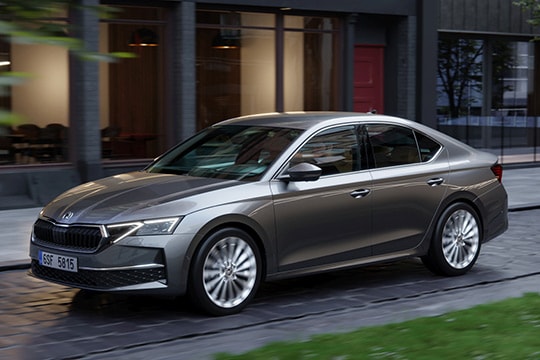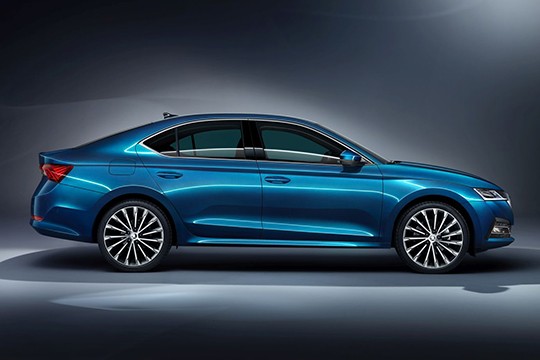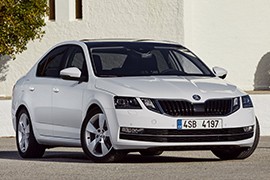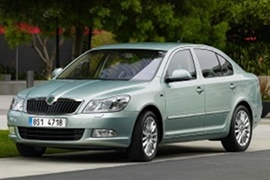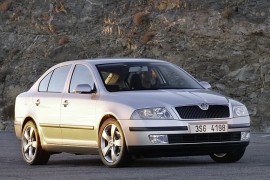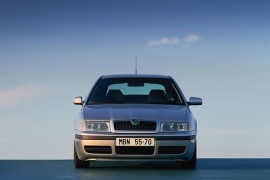SKODA Octavia Models/Series Timeline, Specifications & Photos
First production year: 1997
Engines: Gasoline, Mild hybrid, Diesel, Hybrid, Natural gas
In 2024, Skoda introduced an update for the fourth generation of its best-selling model, Octavia, enhancing the car’s exterior, interior, and some of its safety systems.
The Czech automaker introduced the fourth generation of the Octavia in late 2019. Due to the world pandemic that started in early 2020, the car’s sales and deliveries began only in June 2020. But still, like its predecessors, the compact hatchback was warmly welcomed by customers. After all, it was a larger version of a well-known vehicle, the Golf from Volkswagen. Both of them were built on the same MQB Evo platform, shared with the Audi A3 and the Seat Leon as well. By 2024, customers’ requests were asking for better technologies installed in their cars, so the Czech car manufacturer promptly provided them with the latest that it had in its basket. In addition, it also improved Octavia’s exterior and interior, and that applied to both versions of the vehicle’s bodywork, the hatchback and the station wagon.
One of the most striking upgrades noticed at the car’s front was its new second-generation Matrix LED headlights. Between them, the automaker installed a fresh grille that sported two sets of six vertical double-slats that flanked the radar for the advanced safety systems. Furthermore, the lower bumper gained a new pattern for the lower air intake and was flanked by a set of scoops that formed the air curtains that lowered the car’s drag coefficient.
From its profile, the car’s overall shape remained the same, but it boasted new designs for the wheels, which ranged in size from 16- to 19-inch. Skoda offered the Octavia in a choice of four grades: Essence, Selection, Sportline, and RS. The chromed trim that surrounded the window area offered the vehicle an elegant appeal even when it was in its sportiest-looking version. Finally, at the back, the automaker installed a new set of taillights featuring dynamic turn signals.
But customers could feel the upgrades when they stepped inside the cabin. In terms of technology, the 2024 Octavia came with a new ChatGPT-based Laura assistant for the infotainment system, which was available with a 13-inch touchscreen mounted atop the center stack. Skoda said that the new system could understand voice commands better than the non-facelifted version. The driver fronted a 10-inch display named Virtual Cockpit for the instrument panel.
Under the hood, Skoda installed a wide choice of engines ranging between 115 PS (113 hp) and 265 PS (260 hp), either gasoline or diesel. All versions were turbocharged, and some of them were available with mild-hybrid technology. The car was available with a front- or an all-wheel drive system. Depending on the version, customers could get the 2024 Octavia with a six-speed manual or a seven-speed automatic (dual-clutch) gearbox.
In 2019, Skoda introduced a brand-new generation, the fourth, for its successful model Octavia, and made it with either a hatchback or a station wagon shape.
The fourth generation of this unusually long compact-sized hatchback for the European market shared its underpinnings with the Volkswagen Golf and the Audi A3, to name just a few. Its MQB platform proved successful despite its drawbacks when it came to the base versions of the Octavia, which featured a torsion beam in the back instead of independent suspensions for the entire range like other Octavia generations. Still, the car was successful thanks to its fuel-efficient engines, bold design, and clever solutions that included an umbrella inside the driver’s door and an ice-scraper housed by the fuel door.
Following the same brand’s cubist design language, the fourth generation of the Octavia boasted angular-shaped headlights with L-shaped daytime running lights inside them. There were two of these inside each headlamp, trying to create an aggressive look. One of the most important changes in the car’s design language was the grille, which gained a wide hexagonal shape surrounded by a chromed trim and vertical dark slats for all grades. Underneath it, the bumper boasted a lower, narrower grille that could accommodate the LED fog lamps, offered as an option or fitted as standard, depending on the engine version. From its profile, the Octavia had an ascending waistline emphasized by the sculptured door panels. Another upgrade compared to its predecessor was the rear doors’ design, which featured a bump towards their ending area, creating an angular shape for the windows. In the back, despite the car’s sedan look, it featured a tailgate with a raked forward window. Finally, at the back, the sharp LED taillights were split between the quarter panels and the tailgate.
Skoda offered the Octavia with a wide range of options for the interior. While the base model featured cloth seats and basic instrumentation, the upper trim levels boasted Alcantara upholstery, aluminum pedals, and a floating-style touchscreen for the infotainment system placed atop the center stack. Furthermore, customers could get the car with a complete digital instrument cluster and, as a first for the Octavia, a head-up display. The front occupants could benefit from the heated and ventilated seats, which were on the options list, along with the heated steering wheel. In the back, the split-folding (60/40) bench seat could accommodate comfortably two passengers, but with enough room for a middle-seated one. For the safety package, Skoda offered customers the option to get the car with traffic sign recognition, adaptive cruise control, lane keep assist, and automatic emergency braking system.
Under the hood, the fourth generation of the Octavia came fitted with a wide choice of engines ranging between 110 PS (108 hp) and 204 PS (201 hp) with front or all-wheel-drive systems. A six-speed manual gearbox was standard on lower spec versions, while the upper levels got a seven-speed automatic (dual-clutch) transmission.
Skoda continued the Octavia saga in 2017 by introducing the third-generation facelift, which surprised the customers with its design.
The Octavia was one of the most successful cars built by the Czech carmaker Skoda, and it used the MQB platform, which Volkswagen used for many other vehicles within the group, such as the Golf VII, the Audi A3, or the Seat Leon.
One of the most controversial parts of the car was its front, where Octavia featured a split headlight design. Some considered that it resembled those installed on the Mercedes-Benz' E-Class from the same period, but Skoda claimed it followed the cubist-design style. A wide grille with black vertical slats filled the space between them and featured a small dent on its top for the badge. Even though it looked like a sedan, the Octavia was still a hatchback with a long and sloped tailgate. Its clear-cut rear taillights featured smoked lenses.
Inside, Skoda installed new infotainment units with up to 9.2" touch-screen displays, depending on the trim level. It also allowed 4G/LTE connectivity and featured a 64Gb internal flash memory. The Czech carmaker made a significant step forward on car connectivity by adding the Skoda Connect app, which allowed the driver to remotely check the windows or the fuel level from a smartphone. The 2017 Octavia also featured improved active and passive safety systems, such as traffic sign recognition or City Emergency Brake, including Pedestrian Protection.
Under the hood, Skoda replaced the former 1.2-liter gasoline units with an even smaller, 1.0-liter turbocharged engine. For turbo-diesel units, it limited its offer to just two instead of five as the non-facelifted version.
Skoda introduced the third generation of its best-selling nameplate, the Octavia, in 2013, and it was one of the best choices for families in its price range.
The Czech automaker made the Octavia on the same MQB platform as the Golf 7 or the Audi A3 of the third generation. It also shared some underpinnings with its bigger siblings, the Superb and the Kodiaq. Thanks to this technical solution, prices for it were dropped but without sacrificing comfort or safety. Like in the previous generations, the Octavia was available as a hatchback or as a station wagon.
Sporting a cubist design language dominated by straight lines and clear edges. The Octavia featured a front fascia with angular-shaped headlights. They flanked the grille that was adorned with 21 vertical slats. Behind it, the automaker installed the radar for the adaptive cruise control and the AEBS when fitted with that. On the lower side of the bumper, the car sported a broad secondary grille needed for an additional cooling area, which also housed the fog lamps. At the back, the tailgate offered a vast loading space.
Inside, the vehicle featured nice materials above its price range. At the front, the bucket seats designed for comfort provided minimal side support. The dashboard sported a minimalist design, with a rounded instrument cluster where Skoda installed large dials for the speedometer and tachometer that flanked a TFT display between them. On the center stack, depending on the options, the Octavia featured a touchscreen for the infotainment system. In the back, there was plenty of legroom and headroom for up to three passengers, although the car's interior width was not that great. Behind it, the large trunk competed in size with larger vehicles. In addition, it could be expanded by lowering the split-folding rear bench seat.
Under the hood, Skoda installed a very wide range of turbocharged gasoline, and diesel engines mated with manual or automatic transmissions.
SKODA Octavia 1.2L TSI 5MT FWD (86 HP)
SKODA Octavia 1.2L TSI 6MT FWD (105 HP)
SKODA Octavia 1.2L TSI 7AT FWD (105 HP)
SKODA Octavia 1.4L TSI 6MT FWD (110 HP)
SKODA Octavia 1.4L TSI 6MT FWD (140 HP)
SKODA Octavia 1.4L TSI 7AT FWD (140 HP)
SKODA Octavia 1.8L TSI 6AT FWD (180 HP)
SKODA Octavia 1.6L TDI 5MT FWD (105 HP)
SKODA Octavia 1.6L TDI 5MT FWD (90 HP)
SKODA Octavia 1.6L TDI 6MT AWD (105 HP)
SKODA Octavia 1.6L TDI 6MT FWD (110 HP)
SKODA Octavia 1.6L TDI 7AT FWD (105 HP)
SKODA Octavia 2.0L TDI 6AT AWD (183 HP)
SKODA Octavia 2.0L TDI 6AT FWD (150 HP)
Skoda, part of the VW Group that was one of the most respectable car maker in Europe, decided it was time for a refreshed designed of their best-seller.
Both the exterior and the interior were redesigned, as well as new technologies became available for the facelift version.
From the front, the headlamps became bolder, the radiator grille was restyled and made more robust. At the rear, new lamp covers and a new bumper were the major changes.
For the interior, a new better audio system was offered altogether with a new navigation system.
The quality of the materials used was increased and the steering wheel with the dashboard and the HVAC controls were redesigned. New fabric upholstery was available.
Safety wise, the experience was enhanced with the new adaptive xenon headlamps and the addition of the WOKS headrests for a rear impact better protection.
A new engine was brought in 2009, a 1.4-liter TSI developing 90 kW. The other engine options were the 1.4-liter turbocharged powerplant and the 1.6-liter gasoline, both optionally mated with a 7-speed dual-clutch automatic transmission.
The Octavia, while it was not the most stylish car on the market nor the most equipped with advanced technologies, it was one of the roomiest and most economical, comfortable and easy to live with vehicle, all at a good price.
Skoda unveiled the second generation of the Octavia at the 2004 Geneva Motor Show, and it proved that the success recorded with its predecessor was not an accident.
Built on the PQ35 platform used by the Volkswagen Golf V, the Octavia II was a significant step forward for the Czech carmaker. While the first generation looked more like a budget car, its successor was already in a different league. Volkswagen already prepared Skoda to compete against more notorious carmakers such as Renault, Opel, or Fiat. Skoda was no longer the Cinderella of the VW group.
The Octavia featured a bolder front fascia with a tilted backward grille with vertical slats. Its wedged-shaped headlights followed the cubism design trend and created a corporate identity to the Czech carmaker. Like its predecessor, it featured a hatchback-style bodywork with a sloped liftgate at the back. Its taillights sported a clear C-shaped reversing light, which stood from “Clever”.
Inside, it was bigger than some mid-size sedans on the market. At the front, the new dashboard featured curved lines and aluminum trims on the door panels and the center stack. Its center console was tall and sported a decent storage compartment and the gear-stick (or the gear selector for the automatic transmission version). The Octavia offered seating for five with two bucket seats at the front and a split-folding bench in the rear, which expanded the trunk from 560 liters (19.8 cu-ft) to 1,420 liters (50.1 cu-ft).
Under the hood, Skoda offered a choice of seven engines carried over from Volkswagen. The carmaker paired them with either a manual or an automatic (dual-clutch) gearbox, depending on the trim level and power.
After Volkswagen bought Skoda, the first project was to enhance the already existing Favorit and transform it into the Felicia. But it did that just to buy time and create the Octavia, Skoda's first big hit on the European market.
The Octavia was based on the same platform as the Volkswagen Golf IV, the Audi A3, and the Audi TT. It was available in two bodywork versions, hatchback and station wagon, and was available with a wide engine range. Moreover, the car entered the World Rally Championship, but without any noticeable results. But it was there, at the same table with the Mitsubishi Lancer, the Subaru Impreza, and the Ford Focus WRC.
In 1996, the carmaker launched the Octavia as the biggest model in Skoda's stable. Its styling was inspired by the Czech cubist trend, featuring angular shapes and flat, slightly curved surfaces. At the front, the black vertical slats on the grille were surrounded by a chromed rim, with the green logo on the upper-middle side. A black plastic molding protected the bumpers from scratches. The profile revealed a sloped tailgate adorned with a small wing, depending on the version.
Inside, users found it very Volkswagen-ish, with big dials for the speedometer and tachometer and two smaller gauges between them. In addition, an LCD filled the center of the instrument panel with information from the onboard computer. The center stack hosted the sound system and, as an option, the AC controls. Its front seats were slightly bolstered. In the back, the rear passengers could sit on the split-folding bench that expanded the trunk to 1,328 liters (46.7 cu. ft.).
Under the hood, the entry-level version featured a sluggish yet fuel-efficient, 1.6-liter powerplant. At the other end of the scale stood the Octavia RS that sported a turbocharged 180 hp powerplant carried over from the TT.
